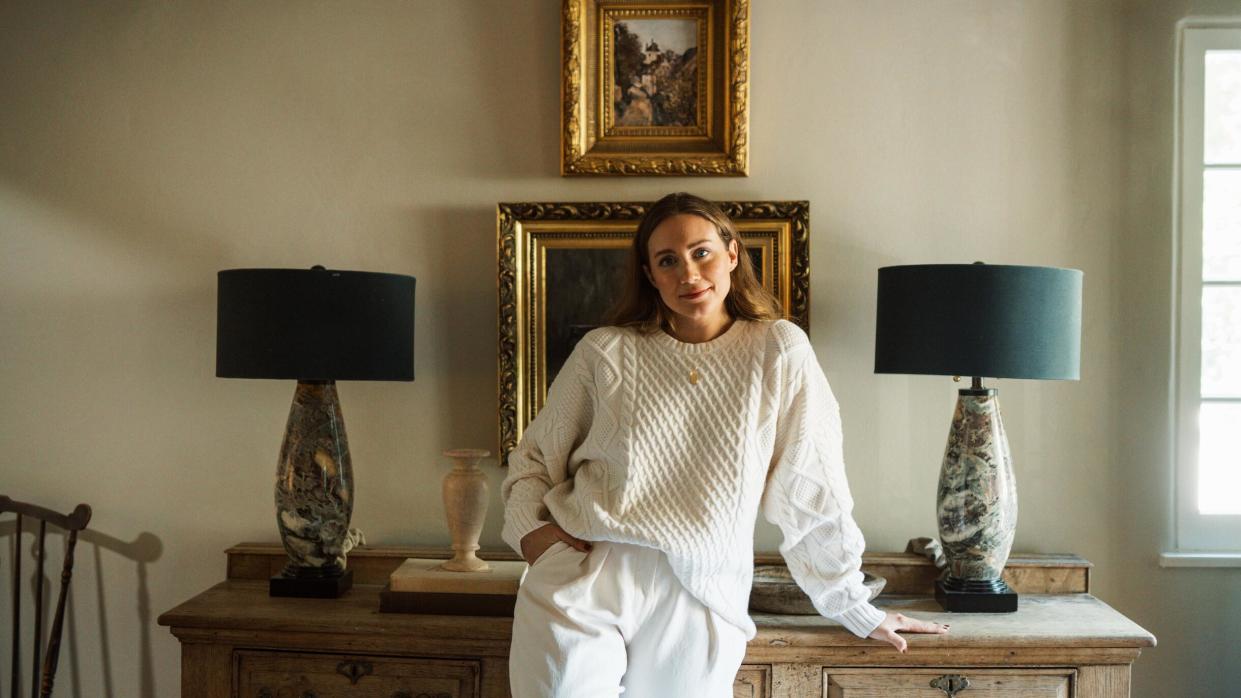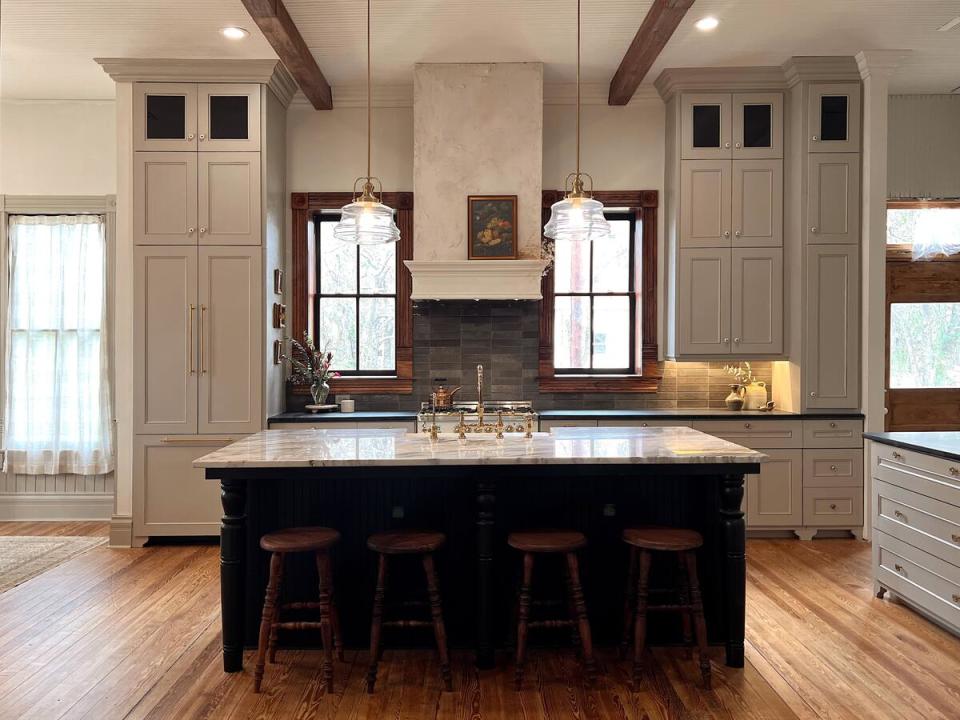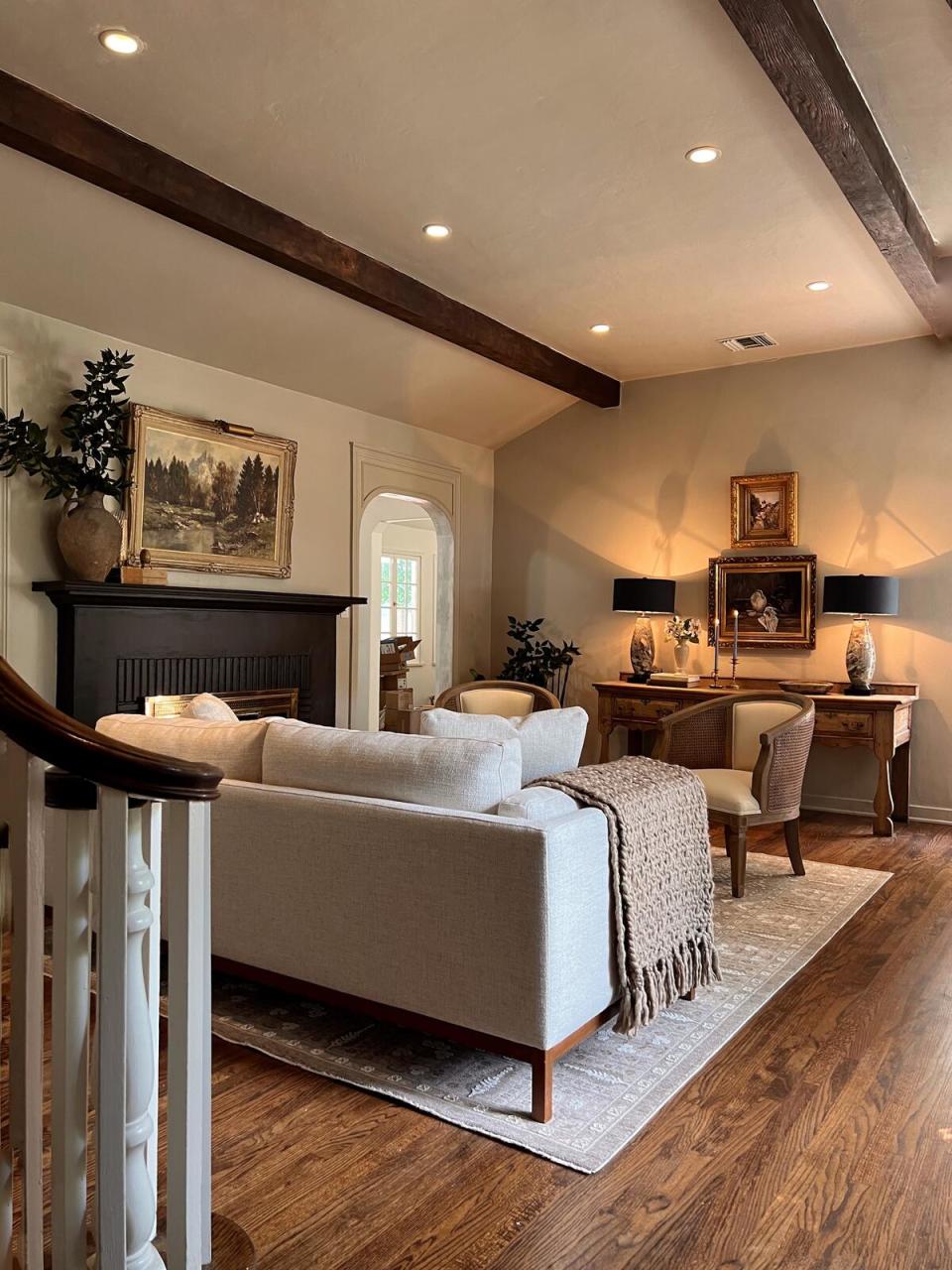How YouTube led influencer MaCenna Lee to product design

Social Media | Feb 7, 2024
In Ask an Influencer, Business of Home explores the creator economy. This week, we spoke with MaCenna Lee, the content creator behind @XOMacenna.
For MaCenna Lee, design was always the family business. When she was growing up in a small town near Houston, her mother, an interior designer, would take her along to visit projects, giving her a front row seat to the creative process. When her mom launched her own home decor boutique, Lee helped her sell products and decorate clients’ homes. By high school, she had developed a distinct style and was even taking on clients of her own.
Lee went on to earn a degree in fashion and then a BBA—before graduating straight into the 2008 recession, which meant a slew of jobs like waitressing, bartending, delivering pizzas and countless unpaid internships. After a few years, she finally landed the job she thought she’d been waiting for: marketing and social media at a fashion design firm.
Lee climbed the corporate ladder all the way to vice president of marketing before the realization hit her: “I had lost all my creativity,” she says. “Even though I had a great job, and anyone would be crazy to leave it, I did it. I didn’t know what I was going to do, but I started to reconnect with home decor.”
She began by redesigning the small Los Angeles apartment she shared with her boyfriend, and she started her own YouTube channel in 2017 to document the process—and build a future social media business. In the years since, her following has skyrocketed to 951,000 subscribers on YouTube and 602,000 followers on Instagram.
Ahead, Lee shares the strategies that turned her followers into a community, her incremental approach to increasing the quality of her content, and how she’s safeguarding her social media business against broader economic uncertainties.
When did you find a social media strategy that worked for you?
In the beginning it was really about following what I saw was working for other people and comparing myself: “What do I want to share online? What interests me? What am I watching?” YouTube was a world I understood from a marketing perspective, and when I thought about what platform [to focus on], I knew that was where we were going to make money. I knew that YouTube, owned by Google, was the most robust platform in rewarding their creators for creating content. It was also where I personally was absorbing content.
[As for] creating content, [I focused on] what I saw was working for other people in my niche. At the time, DIY projects were really popular, so those were the videos I started creating. I was on a very limited budget, so I would go to a thrift store, and if I could find something for $10 and transform it for my house, I would create a video. That’s what kicked off my channel.

On one side of it, you’re being creative, and you’re sharing your personality online, and you’re being a content creator, but 50 percent of it is a business. I have started companies that failed, and I needed this to work if I was going to dedicate my full time and energy to it. I needed to make an [steady] income, so it wasn’t a matter of, “I don’t care if I’ll be getting money from it.” We don’t really talk about [social media] as a business—content creators kind of shy away from that—but it’s so real, it’s so relevant, and it is a big business.
What did it take to grow your following?
You have to look at the business in terms of, “OK, I’m going to focus on YouTube. How do I start making money on YouTube?” They have these thresholds that you had to hit—at the time it was 1,000 subscribers and 4,000 watch hours, and that was the hardest to hit. I posted my first video in August of 2018, and I didn’t hit those milestones for an entire year. [Once I did,] I was like, “People are coming back and watching, and they're interested in what I’m creating and anticipating the next thing. Maybe I can ask them what they want to see next.” And then the community-building kicked off.
What does the process of producing content look like for you?
As I grew, it was really important for me to increase the quality of my videos. A better camera, better lighting, better audio—all of these things increase the viewers and the community’s experience. I was completely self-taught in terms of editing, storytelling and creating, so it was important for me to learn as I went. Every month I was giving myself a goal, like, “OK, what can I do this month to get better?” Maybe it was getting that editing software or upping the camera quality. You can still be a great content creator with an iPhone, but especially on YouTube, I think there’s a higher standard.
I have no one editing my videos—I have had help along the way, and it just doesn’t work for me. It’s part of my process and my creative storytelling: I’m directing a video when I’m filming it, and only I know how I want it to come out. It’s always been easier for me to execute on my own—and I enjoy it, so everything creative is done by me. I have a lot of help on the business side, for sure.
What does that help look like—and how did you know you needed it?
Moving from a corporate world to a world where I had more creative stimulation, I knew I needed to protect my creativity. I was spending a lot of time navigating contracts, negotiating my pay in a world that I wasn’t all that familiar with. I knew that would take me away from being creative. About a year and a half after starting my YouTube channel, I signed with Select Management, and it was the best decision I ever made. Because they handle the business, everything funnels through them, and I get to stay creative.
What does your business look like today?
In 2021 and 2022, it was really big for me to start thinking about diversification, because I never wanted to put all of my eggs in one basket and have all of the income from one stream. I had focused on YouTube for so long, but there are multiple [potential] streams of income on each platform, from brand deals to ads. It was really about looking at everything that was possible and figuring out what I legitimately enjoyed doing.

Since the beginning I’ve always known that most content creators eventually create their own product. When it came to how to create a product … I didn’t want to do what other content creators would call “merch”—hoodies or a T-shirt with some slogan. But I still wanted my own product, and it was an important avenue for the business having control over a product that I promoted on my channels. So, we started out on the adventure, and it’s been almost five years in the making of me creating my own candle line. I wanted to create something that was quality and could also be more sustainable and able to be reused. That’s been the biggest revenue stream in terms of diversifying, and it puts us in a realm where we’re not so dependent on brand deals or how well [a certain] brand is doing this year and how that’s going to affect my [business] income. I have something else to rely on.
Then I also have brand deals, commissions, links through [creator monetization platform LTK,] an Amazon storefront, a blog … It’s like spokes on a wheel. It’s so important as a content creator because sometimes—we saw it in early 2020—things can turn off, and it’s important to have more control.
Why did you choose YouTube as your main platform—and would you recommend other designers join?
I think most designers don’t get into YouTube right away because it’s so much more of a commitment. It’s long-form content, and it’s so much more work than posting a picture or a Reel on Instagram. There’s a lot of work that goes into that too, but to keep people’s attention span for longer than a few minutes and to really gain a community on YouTube is a lot of work. But it’s so much more rewarding. The community on YouTube is so much more engaged and in tune with who you are—and they care. If I post something on TikTok, it’s going to be seen by a lot of people who don’t know me, who don’t care. Virality and all of that is something I don’t really care about, because it’s not where I’ve known success to really come from.
In the beginning I told people when they asked what I do that I’m basically an interior decorator that created her own TV show, just not on a network. For instance, a designer [on TV] is filming an entire house renovation, and that’s exactly what I did at our old cottage: I spent two and a half years renovating and demoing and designing and building and all of the above on my channel, and I created a renovation series and turned it into a TV show on YouTube. People tuned in every week to see what new things were happening. It’s on YouTube as opposed to a network, but you’re controlling the narrative and you have so much freedom with what you post.
How are you thinking about video content on other platforms?
For me and my friends in the space with similar audiences and storytelling [styles], it is really hard to transition into this more short-form type of mentality and content. It’s been my biggest struggle, especially because I know that’s where the world is heading and that short form has become so much more important. Even though I know people can be so successful with it, I have my own success, and I truly believe in staying where you feel like you fit.
With consistency, we see success, time and time again. It’s like the number-one thing that [social media experts] tell you: Be consistent if you’re going to show up somewhere. I felt like the only place that I could really show up consistently was on YouTube, because I enjoyed it so much, and my community could depend on it because I was always there and was always going to bend over backwards to show up.

Do you try to keep up with algorithm changes?
As I grew on YouTube, it became less of a priority for me, because I didn’t depend so much on the algorithm. I had built a community that would seek me out no matter what the algorithm was delivering to them. Once you do that and you have these people who are actually paying attention—who subscribe and turn on their notifications and … know that you show up every Tuesday, Thursday and Sunday—they’re going to come no matter what’s on their homepage. The longer you’re on a platform, the less dependent you become on what the algorithm could do.
Do you have any advice for designers looking to boost their followings?
I think some designers come across as “I want to teach and give advice,” but there’s not a conversational exchange. That’s where engagement really comes from. Maybe they’re sharing “Top 10 things I’m doing in clients’ houses this year,” but instead of just leaving it on the table where you’re the authority and the expert of it, [think about] saying, “What do you think about this? Do you like these? Is this something you would do in your house?” Asking questions and giving people a reason to engage with your video is huge. There are a lot of designers—and I’ve fallen victim to this too—that think, “Well, I don’t want [my audience’s] opinion on it. These are my opinions.” That’s not going to give you any engagement.
Make sure that you’re aware of the conversation that you’re trying to have on social media. It could be just at the end of every video and unrelated to the content that you just shared: “What do you want to see next?” That can not only give you more engagement, but also give you more ideas.
What’s something you’re working on right now on social media from a business perspective?
The difference between long form and short form is definitely a struggle for me. From a production standpoint, it’s unbelievably hard when you’re one person with a tripod in a room, working on a design project and now know you not only have one big video to edit, you should also make 20 short-form content pieces from the same thing. It’s too much. It’s like, how much can you do and keep your sanity? I feel pressure as a content creator to be all things on all platforms to all people—and if not, I’m missing an opportunity. I’ve come to realize in the last couple of months that you can’t be all things to all people.
I feel like we can get trapped in [these ideas of]: “To be successful on TikTok you have to post three times a day,” and follow the advice of other people on how to be successful, or otherwise don’t do it at all. I decided in 2024 I was not bringing that with me. It was more about, “How can I show up if I want to take advantage of these newer kinds of platforms? How can I keep my sanity in content creation?” For me on TikTok, I can show up twice a week. What’s going to grow from that, I’m not sure, but it’s more about having one platform and one thing you do really well that you can depend on. Authenticity and being consistent and showing up for people trump everything else.
Want to stay informed? Sign up for our newsletter, which recaps the week’s stories, and get in-depth industry news and analysis each quarter by subscribing to our print magazine. Join BOH Insider for discounts, workshops and access to special events such as the Future of Home conference.

